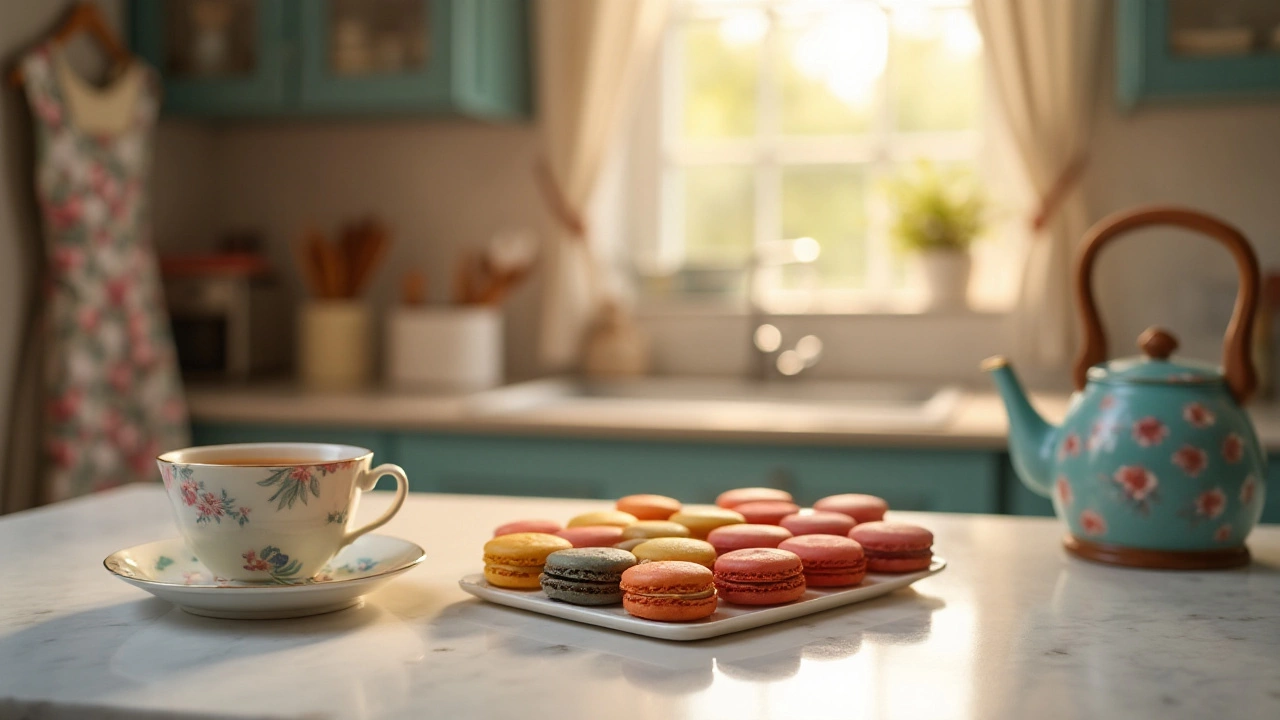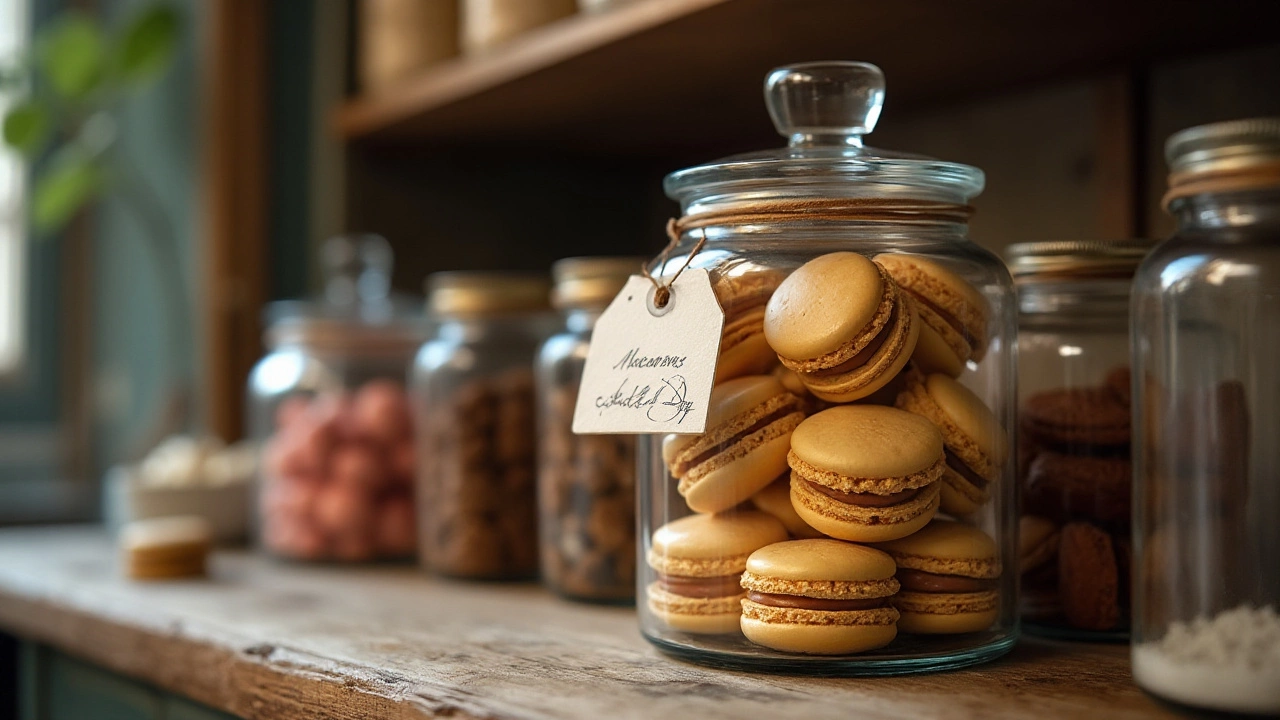
Macarons, with their colorful shells and delicate fillings, are a pastry lover's dream. However, their unique texture and flavor can easily be compromised if not stored correctly. Whether you have a fresh batch from your favorite bakery or some homemade creations, knowing how to keep them fresh is essential.
In this guide, we unravel the secret world of macaron storage. From understanding the basic ingredients that make these treats so special to figuring out if they should go in the fridge or stay on the counter, you'll find everything you need to ensure your macarons stay delicious. Let's dive into the best ways to keep your macarons as delightful as ever!
- Understanding Macaron Composition
- Room Temperature vs. Refrigeration
- Long-Term Storage Techniques
- Enhancing Macaron Enjoyment
Understanding Macaron Composition
When we bite into a macaron, we experience a symphony of textures and flavors. These dainty delights might look simple, but they're a masterclass in balancing ingredients. The basic macaron is a meringue-based confection made from egg whites, icing sugar, granulated sugar, almond meal, and food coloring. Each component plays a crucial role. The egg whites are beaten into a stiff meringue, providing that airy texture. The granulated sugar helps stabilize the meringue, ensuring it holds its shape. Icing sugar and almond meal create a smooth, slightly chewy shell when baked.
The shells, with their crisp outer layer and chewy inside, sandwich a tantalizing filling that often includes buttercream, ganache, or jam. These fillings are not just for taste; they give structural integrity, holding the macaron together. The challenge comes in achieving the perfect balance of these elements. Too much moisture in the filling can cause the shells to soften, which is why the choice of filling affects storage considerations significantly.
"Macarons are a study in chemistry, a baker's balancing act," says renowned pastry chef, Pierre Hermé.Understanding the chemistry behind these delights helps in appreciating why different storage methods impact their longevity and taste. The almond meal imparts a rich, nutty texture that works harmoniously with both sweet and savory flavors.
Not to forget, the visual appeal of macarons is enhanced by vibrant colors, achieved through food coloring. But this isn’t just for show—it points to the eclectic range of flavors you can expect inside. With such precise composition, it's no wonder storing these treats requires a nuanced approach. As such, macaron ingredients need to be fresh and precise; even a slight alteration can result in macarons that differ starkly from the desired outcome. Knowing these elements aids macaron enthusiasts in selecting the best storage options.
As you enjoy your macarons, think of the layers of flavors constructed through skilled mixing, careful baking, and chosen fillings. In mastering macaron storage, honoring this meticulous makeup is the key.

Room Temperature vs. Refrigeration
When it comes to storing macarons, the debate between room temperature and refrigeration is one that has pastry enthusiasts divided. Understanding the pros and cons of each storage method is essential to maintaining the delicate balance of textures that make these treats irresistible. Macarons are essentially made up of two main components: the shell and the filling. Each of these components interacts with the environment in different ways, influencing how long they stay fresh. At room temperature, macarons are at risk from moisture and other ambient factors that can make the shells soft or alter the filling's consistency.
Room temperature is often recommended for enjoying macarons at their peak. That's because the filling needs time to meld with the shells, a process known as maturation, which occurs best outside of the fridge. However, leaving them out for too long can lead to dehydration, leaving your pastries dry and crumbly. It's generally a good idea to consume them fresh unless refrigeration is necessary. Interestingly, professional bakers such as Pierre Hermé, renowned for his macarons, suggest a balance between both methods—saying that properly refrigerated macarons can be just as flavorful.
"Refrigerating macarons can actually enhance their flavors," says Pierre Hermé, noting the importance of airtight containers.
Refrigeration is recommended when you're planning to keep your macarons for an extended period. The cold helps preserve the freshness by slowing down the process that leads to spoilage. Still, you must ensure they're secured in an airtight container to keep them from absorbing other odors. However, there's a draw: cold temperatures can slightly harden the macaron shell. Once you remove them from the fridge, it's advisable to let them come to room temperature before consumption, allowing the shells to regain their lovely crispness and the filling to soften up. Regular refrigerators tend to dehumidify, which can be a concern for macarons if not stored properly.
If you're contemplating the use of refrigeration for long-term storage, you might wonder about the ideal conditions. Most experts say the perfect temperature hovers around 4°C (about 39°F). Beyond that, significant temperature fluctuations may impact the texture. Try experimenting within this temperature range to achieve the best result. If you have a penchant for homemade varieties and are creating your own array of vibrant colors and flavors, you might discover that different fillings react differently. Some compromises might require a bit of trial and error to reach your personal storage nirvana.
For those looking into hybrid storage methods, here are some tips to optimize the best of both worlds: start by allowing your macarons to sit out for a few hours post-baking to let the shells absorb some moisture before opting for refrigeration should you need to store them for a few days. Before serving, don't forget to bring them back to room temperature for the full flavor experience. This can substantially enhance the texture and taste, whether you're dealing with a rich chocolate ganache or a fruity jelly filling. It's all about finding that sweet spot between freshness maintenance and flavor preservation.

Long-Term Storage Techniques
When it comes to prolonging the life of your delicate macarons, several effective strategies ensure they retain their flavor and texture. Although these treats are best enjoyed fresh, there are ways to store them if you need to hold onto their magic for a bit longer. Whether you're dealing with leftovers from a special occasion or preparing them in advance for a future event, learning these techniques can be a game-changer.
One popular method involves freezing macarons. Freezing is an excellent option to keep your macarons fresh for extended periods, typically up to three months. The freezing process preserves both the texture and flavor of the macarons. To do this correctly, it's crucial to ensure that they are well-protected from air and moisture. First, arrange the macarons in a single layer on a baking sheet and freeze them for a couple of hours. Once they're solid, transfer them to an airtight container or a zip-lock bag, ensuring there's minimal space left for air. This will help prevent freezer burn and maintain quality. Make sure to place parchment paper between layers if you're stacking them to avoid them sticking together.
When you're ready to enjoy your frozen macarons, gradual defrosting is key. Move them from the freezer to the refrigerator and let them thaw for several hours, ideally overnight. This step helps protect their delicate shells from forming condensation. Once they reach refrigerator temperature, bring them to room temperature before serving. This final step allows the fillings to soften and achieve the perfect consistency. Remember, careful handling is essential since these pastries are prone to cracking under temperature stress.
Refrigeration is another approach for storing macarons if you're looking to keep them fresh for up to a week. In the fridge, it's crucial to place the macarons in an airtight container. A good tip to preserve taste is to ensure the container is sealed to prevent the delicate treats from absorbing odors from other foods. This method is particularly useful if you're dealing with fruit-based fillings or dairy-based ganache, which benefit from a cooler environment to prevent spoilage.
When it comes to indulging in one of life's sweet little pleasures, treating macarons with care during long-term storage not only prolongs their shelf life but also ensures every bite is as delightful as the first. Taking the time to store these treats properly not only reflects our respect for the artistry involved in creating them but also our desire to savor these confections at their best. As the famed French pastry chef Pierre Hermé once shared,
The macaron is the humble home to infinite possibilities of taste and color combinations.
- Ensure macarons are at peak freshness before freezing or refrigerating.
- Use airtight containers to maintain the original texture and flavor.
- Thaw frozen macarons gradually for optimal enjoyment.

Enhancing Macaron Enjoyment
There's nothing quite like biting into a perfectly crafted macaron. The light crispness of the shell giving way to a tender, flavorful filling is an experience in itself. To fully enjoy macarons at their best, it's about more than just having fresh confections—it's how you savor them. First, allow your macarons to reach room temperature before consuming. This brings out the flavors and ensures the texture is just right. Cold macarons might feel harder and their delicate subtleties masked, so patience pays off here. By waiting a few minutes after taking them out of the fridge, you draw the fullest enjoyment from their craftsmanship.
Having a clear understanding of your flavor preferences can greatly enhance your macaron enjoyment. Some prefer fruity combinations, while others might lean towards rich, chocolate infusions. Experiment with different flavors and take note of the ones that resonate with your palate; this ensures your next purchase or homemade batch is a set of flavors you truly cherish. For gathering ideas or finding new flavor inspirations, attending a local macaron tasting event can be eye-opening. In such events, confectioners showcase their talents, often including rare or seasonal ingredients that could broaden your taste horizon.
The environment in which you enjoy your macarons can also enrich the experience. Pairing these delicate desserts with the right beverage is like matching wine with cheese. Try serving them with a side of tea or a glass of champagne, as these drinks often complement the intricate flavors without overpowering them. Similarly, coffee, especially lighter roasts or cortados, can create harmony, amplifying the taste experience. According to Pierre Hermé, a renowned Parisian pastry chef, "The perfect pairing between a finely crafted macaron and the right beverage adds a new level of depth, emphasizing the delicate nuances of flavors present."
Embrace the social side of enjoying macarons, too. Sharing these sweet treats with loved ones can make the experience memorable. Set up a simple macaron-tasting gathering, where everyone can bring a box of their favorites to share, creating a delightful array of flavors. Include a scoring sheet to rate each macaron based on various factors like texture, flavor depth, and appearance, sparking interesting conversations and debates. Not only does this add joy to the enjoyment, but it also builds a community of fellow macaron enthusiasts sharing a common love.
For those keen on taking their enjoyment a step further, consider crafting your own macarons at home. The process can be an art form, where patience meets creativity. You'll have control over every ingredient and can customize fillings to match personal tastes. There are plenty of online classes and workshops available that guide you through the process, making the art of macaron-making accessible to everyone. The act of creating these confections can itself be joyous, with the reward of savoring something you crafted with your own hands.
- tags : macarons storage freshness refrigeration